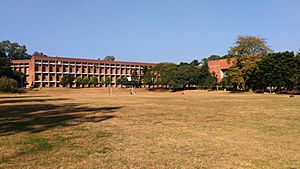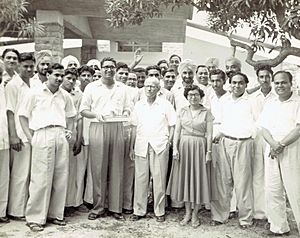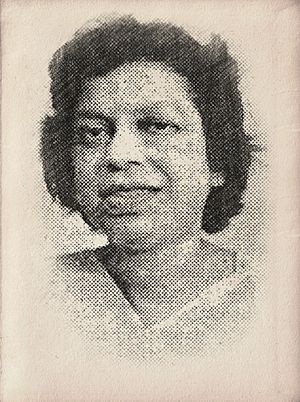Eulie Chowdhury facts for kids
Quick facts for kids
Eulie Chowdhury
|
|
|---|---|
 |
|
| Born |
Urmila Eulie Chowdhury
4 October 1923 Shahjehanpur, Uttar Pradesh, India
|
| Died | 20 September 1995 (aged 71) Chandigarh, India
|
| Nationality | Indian |
| Occupation | Architect, landscape architect, designer, teacher, and writer |
Urmila Eulie Chowdhury (born October 4, 1923 – died September 20, 1995) was an amazing Indian architect. She worked in the middle to late 1900s. She designed buildings, outdoor spaces, and even furniture. She was also a teacher and a writer.
Eulie Chowdhury was one of the first women architects in India. Some people even say she was the first female architect in all of Asia! After finishing her studies, she worked closely with a famous architect named Le Corbusier. They helped plan and build the city of Chandigarh in India.
Contents
Early Life and Education
Eulie Chowdhury was born in 1923 in Shahjehanpur, a city in Uttar Pradesh, India. Her father was a diplomat, which meant her family traveled a lot. Because of this, she grew up seeing many different parts of the world.
She went to school in Kobe, Japan, where she earned a Cambridge School Certificate. Later, she studied architecture at the University of Sydney in Australia. She also studied music at the Julian Ashborn School of Art in Sydney. Eulie Chowdhury even earned a degree in Ceramics in Englewood, New Jersey, in the United States.
She was married to Jugal Kishore Chowdhary. He was also an architect who worked for the government of Punjab.
A Pioneer Woman Architect
Eulie Chowdhury was one of only a few women architects working in Asia during her time. Some people believe she was the very first woman architect in Asia. However, other women like Perin Jamsetjee Mistri and Dora Gad worked even earlier.
After working for a short time in the United States, Eulie Chowdhury returned to India in 1951. She joined a special team led by Le Corbusier. This team was planning and building the new city of Chandigarh. She worked on this project from 1951 to 1963 and again from 1968 to 1970.
She was a very important link between Le Corbusier, another architect named Pierre Jeanneret, and the Indian architects and leaders. She helped everyone communicate and work together.
Designing Buildings in Chandigarh
Eulie Chowdhury designed many important buildings in Chandigarh. These included the Home Science College and the Women's Polytechnic. She also designed many homes for government ministers.
From 1971 to 1976, she became the Chief Architect for Chandigarh. In this role, she led the second phase of planning for the city.
Teaching and Writing
From 1963 to 1965, Eulie Chowdhury was the Director of the School of Architecture in Delhi. During this time, she also wrote a book about her memories of working with Le Corbusier. The book was called Those Were The Days.
She also held important government positions. In 1970, she was the Chief State Architect of Haryana. From 1976 to 1981, she was the Chief State Architect for the state of Punjab.
Designing Furniture
Eulie Chowdhury's work was greatly influenced by the local climate and the available space. She also designed furniture. She even adapted furniture designs by Pierre Jeanneret to be smaller. This might have been because she herself was petite.
Later Life and Contributions
Eulie Chowdhury retired from public service in 1981. After that, she started her own private architecture business in Chandigarh.
She was involved in many publications. She translated Le Corbusier's book, Three Human Establishments, from French to English. This translation became an official publication for the Punjab government. She also wrote articles for famous magazines like Progressive Architecture, Architectural Design, and Casabella.
In 1983, she helped start the Alliance Française de Chandigarh. This organization promotes French language and culture. She also wrote articles for a newspaper called The Tribune. She had a column called Sinners and Winners.
Death and Legacy
Eulie Chowdhury passed away on September 20, 1995, in Chandigarh, India. She is remembered as a pioneering woman in Indian architecture. She opened doors for other women in the field.
See also
 In Spanish: Urmila Eulie Chowdhury para niños
In Spanish: Urmila Eulie Chowdhury para niños





